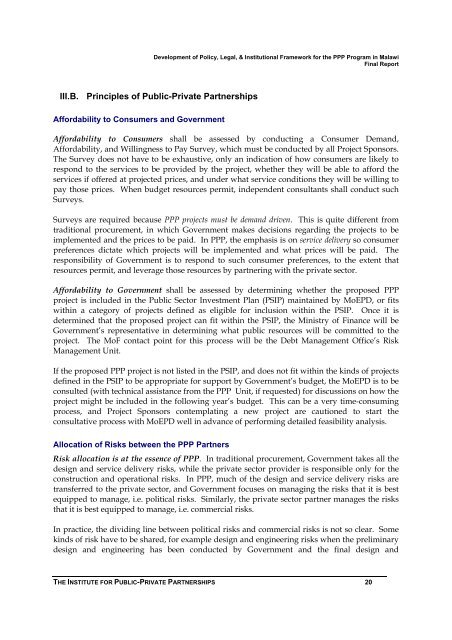Development of Policy, Legal, and Insitutional Framework for - ppiaf
Development of Policy, Legal, and Insitutional Framework for - ppiaf
Development of Policy, Legal, and Insitutional Framework for - ppiaf
Create successful ePaper yourself
Turn your PDF publications into a flip-book with our unique Google optimized e-Paper software.
<strong>Development</strong> <strong>of</strong> <strong>Policy</strong>, <strong>Legal</strong>, & Institutional <strong>Framework</strong> <strong>for</strong> the PPP Program in Malawi<br />
Final Report<br />
III.B. Principles <strong>of</strong> Public-Private Partnerships<br />
Af<strong>for</strong>dability to Consumers <strong>and</strong> Government<br />
Af<strong>for</strong>dability to Consumers shall be assessed by conducting a Consumer Dem<strong>and</strong>,<br />
Af<strong>for</strong>dability, <strong>and</strong> Willingness to Pay Survey, which must be conducted by all Project Sponsors.<br />
The Survey does not have to be exhaustive, only an indication <strong>of</strong> how consumers are likely to<br />
respond to the services to be provided by the project, whether they will be able to af<strong>for</strong>d the<br />
services if <strong>of</strong>fered at projected prices, <strong>and</strong> under what service conditions they will be willing to<br />
pay those prices. When budget resources permit, independent consultants shall conduct such<br />
Surveys.<br />
Surveys are required because PPP projects must be dem<strong>and</strong> driven. This is quite different from<br />
traditional procurement, in which Government makes decisions regarding the projects to be<br />
implemented <strong>and</strong> the prices to be paid. In PPP, the emphasis is on service delivery so consumer<br />
preferences dictate which projects will be implemented <strong>and</strong> what prices will be paid. The<br />
responsibility <strong>of</strong> Government is to respond to such consumer preferences, to the extent that<br />
resources permit, <strong>and</strong> leverage those resources by partnering with the private sector.<br />
Af<strong>for</strong>dability to Government shall be assessed by determining whether the proposed PPP<br />
project is included in the Public Sector Investment Plan (PSIP) maintained by MoEPD, or fits<br />
within a category <strong>of</strong> projects defined as eligible <strong>for</strong> inclusion within the PSIP. Once it is<br />
determined that the proposed project can fit within the PSIP, the Ministry <strong>of</strong> Finance will be<br />
Government’s representative in determining what public resources will be committed to the<br />
project. The MoF contact point <strong>for</strong> this process will be the Debt Management Office’s Risk<br />
Management Unit.<br />
If the proposed PPP project is not listed in the PSIP, <strong>and</strong> does not fit within the kinds <strong>of</strong> projects<br />
defined in the PSIP to be appropriate <strong>for</strong> support by Government’s budget, the MoEPD is to be<br />
consulted (with technical assistance from the PPP Unit, if requested) <strong>for</strong> discussions on how the<br />
project might be included in the following year’s budget. This can be a very time-consuming<br />
process, <strong>and</strong> Project Sponsors contemplating a new project are cautioned to start the<br />
consultative process with MoEPD well in advance <strong>of</strong> per<strong>for</strong>ming detailed feasibility analysis.<br />
Allocation <strong>of</strong> Risks between the PPP Partners<br />
Risk allocation is at the essence <strong>of</strong> PPP. In traditional procurement, Government takes all the<br />
design <strong>and</strong> service delivery risks, while the private sector provider is responsible only <strong>for</strong> the<br />
construction <strong>and</strong> operational risks. In PPP, much <strong>of</strong> the design <strong>and</strong> service delivery risks are<br />
transferred to the private sector, <strong>and</strong> Government focuses on managing the risks that it is best<br />
equipped to manage, i.e. political risks. Similarly, the private sector partner manages the risks<br />
that it is best equipped to manage, i.e. commercial risks.<br />
In practice, the dividing line between political risks <strong>and</strong> commercial risks is not so clear. Some<br />
kinds <strong>of</strong> risk have to be shared, <strong>for</strong> example design <strong>and</strong> engineering risks when the preliminary<br />
design <strong>and</strong> engineering has been conducted by Government <strong>and</strong> the final design <strong>and</strong><br />
THE INSTITUTE FOR PUBLIC-PRIVATE PARTNERSHIPS 20
















